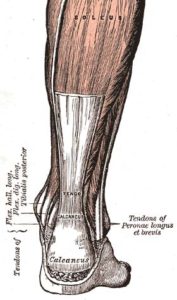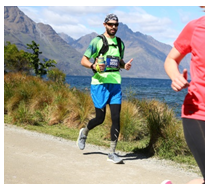What is the Achilles tendon?
The Achilles tendon is the largest and strongest tendon in the human body, it attaches the calf muscles to the heel bone (calcaneus) and is integral for everyday life activities, including (but not limited to) walking, going up and down steps and running.
How does it work?
The Achilles stretches and stores potential energy when the foot hits the ground, then it is used to generate over 50% of the positive work done at ankle during running. Interestingly the Achilles tendon can be exposed to forces up to 6 times body weight during running. Given that optimal running cadence is 90 steps per leg per minute, the total force the Achilles has to endure is considerable.
How can it be injured?
Injury to the Achilles is usually caused by 1 of 3 (or a combination of) things – issues with tensile loading, shearing compressive forces or hyperthermia of the tendon itself.
- Tensile load can be compared to a tug-of-war scenario. Imagine the calf muscle is one team and the heel is the other team, the Achilles is the “rope” that each team is pulling on, if the pull is to great or the rope (Achilles tendon) is to weak then you will have a failure of the rope
- Shearing and compressive loads can be compared to a rope (Achilles tendon) going over a pulley. If you take the example as above about the tensile load being a tug-of-war, as the rope goes over the pulley the compressive load comes from where the rope is contacting the pulley and pulling down into it. This happens where the Achilles attaches into the heel.
- Hyperthermia of the Achilles tendon occurs when the tendon becomes too warm during activity and the heat loss could potentially lead to a change in loading dynamics and lead to injury
How can it be injured?
Injuries to the Achilles tendon can be acute (1st time injury – pushing of at squash and feeling your Achilles “go”) or chronic (persistent) whereby you have a niggle there all the time and it has been there for several months to years. Given the important part that your Achilles plays in everyday walking and activity it is very easy for the acute injury to progress to a more persistent injury if the loading and activity modification is not monitored in the early stages. Interestingly, your body maybe trying to tell you that and injury is coming as 1 in 5 people report calf tightness/soreness prior to injuring their Achilles tendon. Improper running technique can lead to excessive loading through the Achilles and result in an early injury during the training calendar.
How likely are you to get it?
The incidence of an Achilles injury in runners varies from 8-10% of all running injuries and there is some evidence to suggest a small genetic predisposition. Potential risk factors for runner developing or having an Achilles injury include: biomechanical, environmental, age, sex, neuromuscular recruitment and the level at which they are performing their running. Slower paces for recovery and endurance runs have been shown to be less loading on the Achilles while people that run at close to race pace that don’t allow adequate recovery time show increased incidence of Achilles injuries.
What should you do next?
If you are feeling pain, discomfort and/or stiffness in your calf, Achilles or heel region then I recommend you get in contact with us at the clinic and we will be able to help you moving forward with our rehabilitation.
#Acceleratephysio #Achillespain #RunStrong
Until next time,
Joel
Physiotherapist & Exercise Scientist
Certified Professional with “The Running Clinic”


